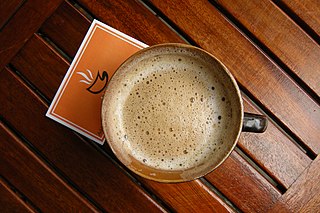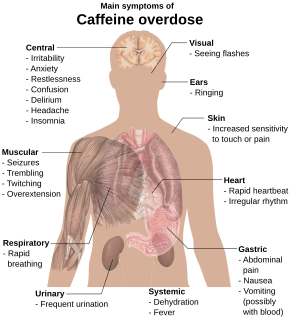
Caffeine is a central nervous system (CNS) stimulant of the methylxanthine class. It is mainly used as a eugeroic (wakefulness promoter) or as a mild cognitive enhancer to increase alertness and attentional performance. Caffeine acts by blocking binding of adenosine to the adenosine A1 receptor, which enhances release of the neurotransmitter acetylcholine. Caffeine has a three-dimensional structure similar to that of adenosine, which allows it to bind and block its receptors. Caffeine also increases cyclic AMP levels through nonselective inhibition of phosphodiesterase.

Alcohol intoxication, also known in overdose as alcohol poisoning, commonly described as drunkenness or inebriation, is the behavior and physical effects caused by a recent consumption of alcohol. In addition to the toxicity of ethanol, the main psychoactive component of alcoholic beverages, other physiological symptoms may arise from the activity of acetaldehyde, a metabolite of alcohol. These effects may not arise until hours after ingestion and may contribute to the condition colloquially known as a hangover. The term intoxication is commonly used when large amount of alcohol is consumed along with physical symptoms and deleterious health effects.

Stimulants are a class of drugs that increase the activity of the brain and the spinal cord. They are used for various purposes, such as enhancing alertness, attention, motivation, cognition, mood, and physical performance. Some of the most common stimulants are caffeine, nicotine, amphetamines, cocaine, and modafinil.

An energy drink is a type of drink containing stimulant compounds, usually caffeine, which is marketed as providing mental and physical stimulation. They may or may not be carbonated and may also contain sugar, other sweeteners, or herbal extracts, among numerous other possible ingredients.

A caffeinated drink, or caffeinated beverage, is a drink that contains caffeine, a stimulant that is legal practically all over the world. Some are naturally caffeinated while others have caffeine added as an ingredient.
Although health benefits have been assumed throughout the history of using Camellia sinensis as a common beverage, there is no high-quality evidence that consuming tea confers significant benefits other than possibly increasing alertness, an effect caused by caffeine in the tea leaves. In clinical research conducted over the early 21st century, tea has been studied extensively for its potential to lower the risk of human diseases, but there is no good scientific evidence to indicate that consuming tea affects any disease or improves health.

Caffeine dependence is a condition characterized by a set of criteria including tolerance, withdrawal symptoms, persistent desire or unsuccessful efforts to control use, and continued use despite knowledge of adverse consequences attributed to caffeine. It can appear in physical dependence or psychological dependence, or both. Caffeine is one of the most common additives in many consumer products, including pills and beverages such as caffeinated alcoholic beverages, energy drinks, pain reliever medications, and colas. Caffeine is found naturally in plants such as coffee and tea and other plants. Studies have found that 89 percent of adults in the U.S. consume on average 200 mg of caffeine daily. One area of concern that has been presented is the relationship between pregnancy and caffeine consumption. Repeated caffeine doses of 100mg appeared to result in smaller size at birth in newborns. When looking at birth weight however, caffeine consumption did not appear to make an impact.
The health effects of coffee include various health benefits and health risks.
Caffeine-induced sleep disorder is a psychiatric disorder that results from overconsumption of the stimulant caffeine. Caffeine is one of the most widely consumed psychoactive drugs: almost 90% of Americans in a survey consume some type of caffeine each day. "When caffeine is consumed immediately before bedtime or .... throughout the day, sleep onset may be delayed, total sleep time reduced, normal stages of sleep altered, and the quality of sleep decreased." Caffeine reduces slow-wave sleep in the early part of the sleep cycle and can reduce rapid eye movement sleep later in the cycle. Caffeine increases episodes of wakefulness, and high doses in the late evening can increase sleep onset latency. In elderly people, there is an association between use of medication containing caffeine and difficulty in falling asleep.

Caffeine is a bitter, white crystalline xanthine alkaloid that acts as a psychoactive stimulant drug. It can have both positive and negative effects on different aspects of memory.
Bromism is the syndrome which results from the long-term consumption of bromine, usually through bromine-based sedatives such as potassium bromide and lithium bromide. Bromism was once a very common disorder, being responsible for 5 to 10% of psychiatric hospital admissions, but is now uncommon since bromide was withdrawn from clinical use in many countries and was severely restricted in others.

Low caffeine coffee is a term that is used by coffee producers to describe coffee that has not been subjected to a process of decaffeination, but is substantially lower in caffeine than average coffee. Samples of coffee vary widely in caffeine levels due to many factors, some well documented and some not fully understood, such as the action of soil, water levels and sunlight. Low caffeine coffees are typically created by assaying caffeine levels of different bean lots and selecting the best flavor profile from the lots that are naturally lowest in caffeine.

A caffeinated alcoholic drink is a drink that contains both alcohol and a significant amount of caffeine. Caffeine, a stimulant, masks some of the depressant effects of alcohol. However, in 2010 and 2011, this type of drink faced criticism for posing health risks to its drinkers. In some places there is a ban on caffeinated alcoholic drinks.

The 17 November 2010 United States ban on caffeinated alcoholic drinks is a ban which prevents the marketing and distribution of any prepackaged caffeinated alcoholic drink.

Alcohol, sometimes referred to by the chemical name ethanol, is a depressant drug found in fermented beverages such as beer, wine, and distilled spirit -- in particular, rectified spirit. Ethanol is colloquially refereed to as "alcohol" because it is the most prevalent alcohol in alcoholic beverages, but technically all alcoholic beverages contain several types of psychoactive alcohols, that are categorized as primary, secondary, or tertiary; Primary, and secondary alcohols, are oxidized to aldehydes, and ketones, respectively, while tertiary alcohols are generally resistant to oxidation; Ethanol is a primary alcohol that has unpleasant actions in the body, many of which are mediated by its toxic metabolite acetaldehyde. Less prevalent alcohols found in alcoholic beverages, are secondary, and tertiary alcohols. For example, the tertiary alcohol 2M2B which is up to 50 times more potent than ethanol and found in trace quantities in alcoholic beverages, has been synthesized and used as a designer drug. Alcoholic beverages are sometimes laced with toxic alcohols, such as methanol and isopropyl alcohol. A mild, brief exposure to isopropyl alcohol is unlikely to cause any serious harm, but many methanol poisoning incidents have occurred through history, since methanol is lethal even in small quantities, as little as 10–15 milliliters. Ethanol is used to treat methanol and ethylene glycol toxicity.
Caffeine-induced anxiety disorder is a subclass of the DSM-5 diagnosis of substance/medication-induced anxiety disorder.

Lithium toxicity, also known as lithium overdose, is the condition of having too much lithium. Symptoms may include a tremor, increased reflexes, trouble walking, kidney problems, and an altered level of consciousness. Some symptoms may last for a year after levels return to normal. Complications may include serotonin syndrome.
Stimulant use disorder is a type of substance use disorder where the use of stimulants caused clinically significant impairment or distress. It is defined in the DSM-5 as "the continued use of amphetamine-type substances, cocaine, or other stimulants leading to clinically significant impairment or distress, from mild to severe". These psychoactive drugs, known as stimulants, are among the most widely used drugs in the world today, although not all stimulants can induce addiction. As of 1993, Approximately 200 million Americans have used some type of stimulant in the past year alone.

Caffeine-induced psychosis is a relatively rare phenomenon that can occur in otherwise healthy people. Overuse of caffeine may also worsen psychosis in people suffering from schizophrenia. It is characterized by psychotic symptoms such as delusions, paranoia, and hallucinations. This can happen with ingestion of high doses of caffeine, or when caffeine is chronically abused, but the actual evidence is currently limited.












